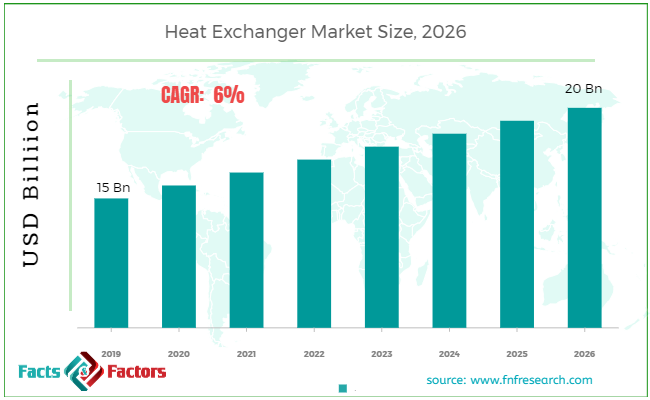 en
en  en
en  en
en  en
en 
[188+ Pages Report] According to the report published by Facts Factors, the global heat exchanger market size was worth around USD 15 billion in 2019 and is predicted to grow to around USD 20 billion by 2026 with a compound annual growth rate (CAGR) of roughly 6% between 2020 and 2026. The report analyzes the global heat exchanger market drivers, restraints/challenges, and the effect they have on the demands during the projection period. In addition, the report explores emerging opportunities in the heat exchanger market.

This specialized and expertise oriented industry research report scrutinizes the technical and commercial business outlook of the heat exchanger industry. The report analyzes and declares the historical and current trends analysis of the heat exchanger industry and subsequently recommends the projected trends anticipated to be observed in the heat exchanger market during the upcoming years.
 Key Insights from Primary Research
Key Insights from Primary Research Key Recommendations from Analysts
Key Recommendations from AnalystsThe quantitative data is further underlined and reinforced by comprehensive qualitative data which comprises various across-the-board market dynamics. The rationales which directly or indirectly impact the heat exchanger industries are exemplified through parameters such as growth drivers, restraints, challenges, and opportunities among other impacting factors.
Throughout our research report, we have encompassed all the proven models and tools of industry analysis and extensively illustrated all the key business strategies and business models adopted in the heat exchanger industry. The report provides an all-inclusive and detailed competitive landscape prevalent in the heat exchanger market.
The report utilizes established industry analysis tools and models such as Porter’s Five Forces framework to analyze and recognize critical business strategies adopted by various stakeholders involved in the entire value chain of the heat exchanger industry. The heat exchanger market report additionally employs SWOT analysis and PESTLE analysis models for further in-depth analysis.
The report study further includes an in-depth analysis of industry players' market shares and provides an overview of leading players' market position in the heat exchanger sector. Key strategic developments in the heat exchanger market competitive landscape such as acquisitions & mergers, inaugurations of different products and services, partnerships & joint ventures, MoU agreements, VC & funding activities, R&D activities, and geographic expansion among other noteworthy activities by key players of the heat exchanger market are appropriately highlighted in the report.
The heat exchanger market research report delivers an acute valuation and taxonomy of the heat exchanger industry by practically splitting the market on the basis of different types, category and regions. Through the analysis of the historical and projected trends, all the segments and sub-segments were evaluated through the bottom-up approach, and different market sizes have been projected for FY 2020 to FY 2026.
 Report Scope
Report ScopeReport Attribute |
Details |
Market Size in 2019 |
USD 15 Billion |
Projected Market Size in 2026 |
USD 20 Billion |
CAGR Growth Rate |
6% CAGR |
Base Year |
2019 |
Forecast Years |
2020-2026 |
Key Market Players |
Alfa Laval, Kelvion Holdings, Danfoss, Xylem, API Heat Transfer, Gunter, Chart Industries, Hisaka Works, Johnson Controls International, and Hindustan Dorr-Oliver, and Others |
Key Segment |
By Type, Material, End-Use, and Region |
Major Regions Covered |
North America, Europe, Asia Pacific, Latin America, and the Middle East & Africa |
Purchase Options |
Request customized purchase options to meet your research needs. Explore purchase options |
The regional segmentation of the heat exchanger industry includes the complete classification of all the major continents including North America, Latin America, Europe, Asia Pacific, and Middle East & Africa. Further, country-wise data for the heat exchanger industry is provided for the leading economies of the world.
To transfer heat between the fluids, a mechanism called a heat exchanger is used. These are commonly used in both heating and refrigeration methods. To avoid mixing, a solid wall separates the fluids. The heat exchanger is used in power plants, heating, natural gas refining, chemical plants, air conditioning, refrigeration, petrochemical plants, water treatment, and oil refineries.
The heat exchanger is commonly used for energy conservation and heat transfer. Various types of heat exchangers are used for industrial and domestic applications such as steam power plants, chemical processing plants, transportation power systems, building electricity, air conditioning systems and others. The heat exchanger market may be powered by the growing use of heat exchangers in the oil and gas industry. Strict government regulations and advanced technologies are driving the heat exchanger market. However, the disadvantages including pressure drops and leakage in the system may restraint the market growth. Conversely, growing R&D activities and economic growth may create ample opportunities in the market.
The heat exchanger market is segmented based on type, material, end-use industry, and region. On the basis of type segmentation, the market is classified into shell & tube, plate & frame, air cooled, others. By material segmentation, the market is divided into steel, and non-steel. And by end-use industry, the market is bifurcated into chemical, energy, hvacr, food & beverages, pulp & paper, power, others.
 Some of the essential players operating in the heat exchanger market, but not restricted to include
Some of the essential players operating in the heat exchanger market, but not restricted to include The taxonomy of the heat exchanger industry by its scope and segmentation is as follows:
 By Type Segmentation Analysis
By Type Segmentation Analysis By Material Segmentation Analysis
By Material Segmentation Analysis By End-Use Industry Segmentation Analysis
By End-Use Industry Segmentation Analysis Regional Segmentation Analysis
Regional Segmentation Analysis

Copyright © 2024 - 2025, All Rights Reserved, Facts and Factors
 en
en  en
en